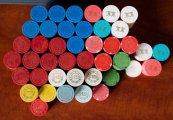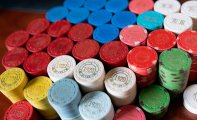The 47% figure comes from a letter that the CEO of GPI wrote to their customers, in which he stated:
Until 1998, these clay chips all contained approximately 47% (that is 470,000 Parts Per Million, or “PPM”) of lead in order to give them the weight that dealers and players were used to. Since 1998, the Paulson chip has had significant reductions in its lead content resulting in chips sold between January 1998 and November 2006 having a lead content of a few thousand PPM to a maximum of 6,500 PPM (0.65% in weight) for most of the approximately 70 colors of the available palette with the exception of 6 colors for which no acceptable formulation had been found until the second part of 2006.
Since November 2006, none of the chips manufactured have had lead levels that exceeded 6,500 PPM (0.65% in weight). Directly as a result of our continuous reformulation processes, we are pleased to report that all Paulson chips manufactured since October of this year have a lead content of less than 50 PPM (0.005% in weight).
In addition,
prior to this letter, there was a TV station that hired a lab to test Paulson chips for lead. Reportedly, the lab determined that the chips contained 47% lead.
All of the above information comes from Key West (a reseller of ASM/
CPC chips), who has posted it here:
https://www.keywestresortcasino.com/the-great-casino-chip-lead-scare.html
There doesn't seem to be first-hand information about where the 47% number came from, since Key West is a secondary source and not a primary source, and the primary sources may be gone (or at least not on the Internet). But it's conceivable that the lab hired by the TV station found 47% and that the Paulson CEO simply repeated that number in his letter without performing any further analysis on their own.
That was in Nov 2007. Paulson said that all newly-manufactured chips were down to 0.005% lead as of Oct 2007. By Aug 2008, the Arizona Department of Health Services had tested Paulson's chips and found that they had "concentrations of lead significantly lower than those reported by the television station". It's not clear that the TV station and the AZ DHS were testing the same chips. This information comes by way of a Aug 2008 report in the Las Vegas Sun:
https://m.lasvegassun.com/news/2008/aug/01/gamblers-be-warned-lead-vegas-companys-poker-chips/
However, I suspect the following:
- The 47% was what one lab found, but labs are full of crap.
- The CEO didn't dispute the 47% figure and in fact repeated it, because Paulson didn't have any way to test it themselves or perform any other sort of analysis to determine what the actual figure would have been for chips that they manufactured ten years previously, and their main task at the time was to send out a reassuring letter to their customers.
- A subsequent analysis by the AZ DHS was probably more rigorous, and while we don't know what number they came up with, or even which chips they tested, it was "significantly less" than 47%.
... and so, accordingly:
- The "47%" figure is just a bunch of crap.
Alas, I have no way to prove my suspicions.
None of this, however, is relevant to ASM or
CPC chips. The TV station's lab tested Paulson chips, the CEO of Paulson wrote about their own chips, and the AZ DHS tested Paulson chips. Nobody else's chips were mentioned in anything connected to the 47% figure.
None of the information we have at our fingertips is primary sources, so there's no good way to even know whether 47% is even being accurately reported (did the lab actually say 470,000 ppm, or was that a misunderstanding?) or, for example, whether the 47% refers to the entire body of a chip or just the minuscule amount of dyes used to color the chip. Diligent research, probably using actual paper records in actual libraries, and possibly including FOIA requests in order to turn up the relevant government documents, might shed more light on this particular subject... but cursory google searches probably won't.





